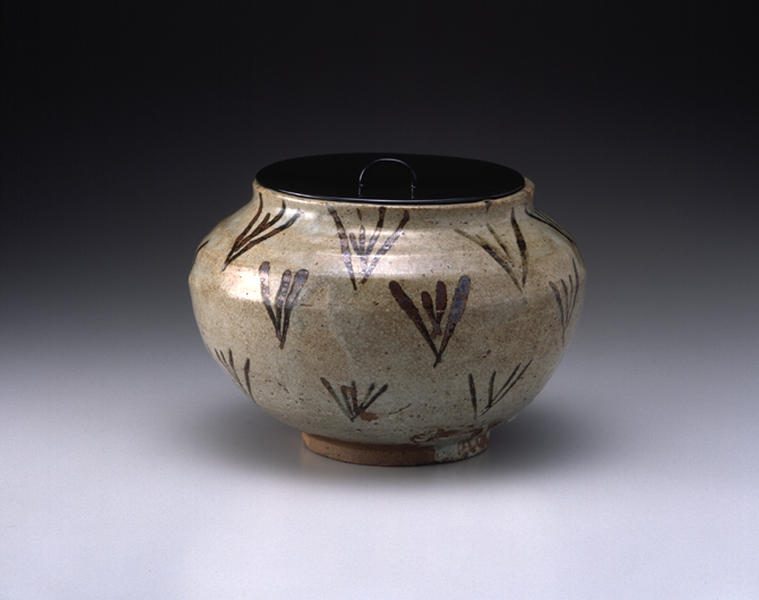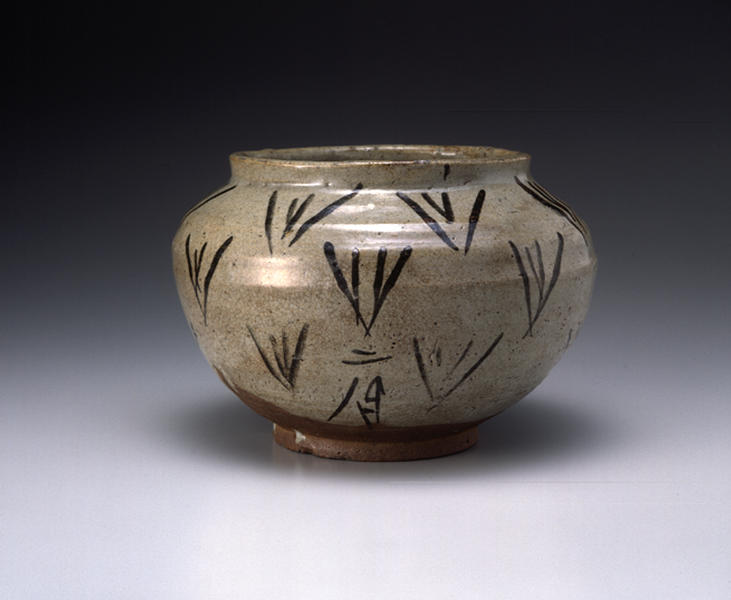絵唐津水指 銘 十字むしもち
- 佐賀県・唐津窯
- 桃山~江戸時代
- 17世紀
- 施釉陶
- H-13.4 D-20
肥前国(現在の佐賀県西部から長崎県一帯)で焼かれた唐津焼は、天正年間がその開窯時期とされているが、大々的に発展したのは豊臣秀吉による文禄・慶長の役(丁酉倭乱)(ていゆうわらん)で朝鮮の陶工たちが日本に連れてこられて以後のことである。桃山時代の作品は特に茶陶に優品が多く、井戸、樂、萩などとともに古くから唐津の茶碗は茶の世界で珍重されてきた。朝鮮王朝期の素朴さを色濃く残す唐津の壺もまた高く評価されている。登り窯の技術導入や製品の図柄の類似性などから唐津と美濃との間には交流があったことがうかがえるが、この手の壺に関していえば美濃では焼かれておらず、唐津で数多く焼かれているのも大きな特徴といえよう。広口の口縁をもち、胴のやや上部が強く張ったこの壺もその好例を示すものである。器面三段に草とも花弁ともとれる他に類例を見ない文様を巡らし、反対面には「二月」と読める文字が記されている。やや青みを帯びた釉調で焼上りはかためである。絵唐津の壺として申し分のない魅力を兼ね備えている本作品は、水指として転用され「十字 むしもち」と銘がつけられている。
唐津焼(からつ)
佐賀県西部から長崎県一帯にかけて焼かれた陶器。窯跡は広範囲に広がっています。開窯時期は天正年間とされていますが、大々的に発展したのは豊臣秀吉による文禄・慶長の役(丁酉倭乱)(ていゆうわらん)で朝鮮の陶工たちが日本に連れてこられて以降のことです。桃山時代の作品は特に茶陶に優品が多く、江戸時代前期までその様式は引き継がれました。
奥高麗茶碗 銘 入舟
瀬戸唐津茶碗
絵唐津筒向付
絵唐津柳文輪花向付
絵唐津矢文向付
奥高麗水指 銘 明月
唐津大皿
本手瀬戸唐津茶碗 銘 雲井
解説(開館1周年記念展)
肥前国(現在の佐賀県西部から長崎県一帯)で焼かれた唐津焼は,天正年間がその開窯時期とされているが,大々的に発展したのは豊臣秀吉による文禄・慶長の役で朝鮮の陶工たちが日本に連れてこられて以後のことである。桃山時代の作品は特に茶陶に優品が多く,井戸,樂,萩などとともに古くから唐津の茶碗は茶の世界で珍重されてきた。朝鮮王朝期の素朴さを色濃く残す唐津の壷も,また高く評価されている。登り窯の技術導入や製品の図柄の類似性などから唐津と美濃との間には交流があったことが窺えるが,この手の壷に関していえば美濃では焼かれておらず,唐津で数多く焼かれているのも大きな特徴といえよう。広口の口縁をもち,胴のやや上部が強く張ったこの壷もその好例を示すものである。器面3段に草とも花弁ともとれる他に類例を見ない文様を巡らし,反対面には「二月」と読める文字が記されている。やや青みを帯びた釉調で焼き上がりはかためである。絵唐津の壷として申し分のない魅力を兼ね備えている本作品は,水指として転用され「十字むしもち」と銘が付けられている。
Catalogue Entry
Karatsu ware has been produced in the region formerly called Hizen, consisting of present-day Nagasaki Prefecture and the western part of Saga Prefecture. Hizen kilns started their operation in the Tensho period (1573-1592), but a great development did not occur until Toyotomi Hideyoshi's troops invaded Korea in 1592 and 1597, and Korean potters were forcibly brought to Japan. Outstanding Momoyama period (1573-1615) works are mostly ceramics used for the tea ceremony, and along with Ido, Raku, and Hagi, Karatsu tea bowls have been highly valued among masters of tea from the beginning. Karatsu jars, too, which inherited the traditional simplicity of the Korean dynasty era, have long been highly treasured. From the shared technology of climbing kilns and the design similarity of their products, we learn that Karatsu and Mino interacted with one another. While this type of pot was produced in large quantities in Karatsu, its counterpart is conspicuously absent in Mino. Having a wide opening and a pronounced shoulder near the top, this jar is a good example of this type of Karatsu ware. Over three parts of the surface of the pot, there are distinctive patterns which resemble grass blades or flower petals. On the back side, two Chinese characters, 二月 meaning "the second month" (early spring) are inscribed. The glaze on this container turned out to be a little bluish, and the firing made the vessel hard. This piece, endowed with the perfect charm of patterned Karatsu (E-garatsu) ware, was diverted to be used as a water jar and is known as "Juji Mushimochi."

